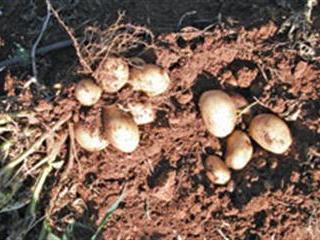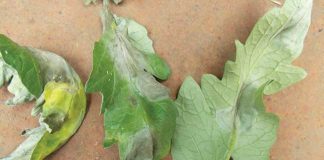
It’s always best to base your fertilisation on a soil analysis. The cost of producing a crop is very high so make sure you provide all the plants’ possible requirements. Remember that if the level of one or more nutrients is considered marginally suitable for other crops, it might be too low for potatoes because the confined root system doesn’t enable the plant to retrieve nutrients from all of the topsoil.
It’s usual to apply the fertiliser with the planter, which usually band-places two strips of fertiliser a little way from the tubers. The roots will then quickly have access to this. Small-scale farmers can apply the fertiliser to the furrows. This is then covered with a few centimetres of soil before the tubers are placed. This crop also responds well to organic matter. Soils with a healthy organic content and structure will be much more productive and easier to manage.
Sprouting
The tubers should have started sprouting at planting. Ideally, they should still be short to avoid damage and should have sprouted uniformly. Variations between well-sprouted and un-sprouted tubers will be seen in timing of emergence and affect subsequent ridging. Plants that emerged earlier will also tend to dominate and, to some extent, shade out plants alongside, causing unevenness.
If the seed potatoes have been kept in cold storage, (usually 3-4°C), remove them about two weeks before planting.
Although not usually practical, unless on a small scale, it’s preferable to expose the seed potatoes to diffused light in thin layers so they become green, causing them to make shorter, stockier sprouts. This is called ‘chitting’.
The size of the tubers to be planted will influence the spacing in the row. It more or less boils down to shoots per metre of row. If, for some reason, they’re too large, they can be cut and treated with a fungicide or lime and the cut surfaces allowed to seal before planting. Large potatoes will produce many more shoots and more tubers, which are then smaller.
The spacing in the row can be adjusted according to the tuber size, variety and desired size required by your market. The seed potato supplier can provide some guidelines in this regard. Between-row spacing is usually about 1m or slightly closer. Tractor wheel spacing and equipment will determine this. In the row, the spacing is usually 25cm to 30cm apart.
Certified potatoes
If you don’t buy certified seed potatoes, there’s a risk of introducing a virus or other diseases. With the price of seed potatoes being a meaningful part of production costs, it is tempting to use uncertified potatoes. If you do so, make sure that they are clean. Some producers keep back smalls from a healthy crop which they have grown on their farms. This they usually do for one generation and the right storage conditions are needed.
However, some claim you can greatly improve your profit margin by adopting this practice. Seed potatoes should be in good condition and not overly shrunken, over-sprouted or with injuries. These will result in a yield reduction. You can either plant into level ground or do some ridging at planting. If you expect a weed problem, the level ground option may be the better choice, as the potato shoots will emerge and grow faster than weeds, while the ridging process will remove and cover weeds in the process.
The planting depth may differ according to variety as some varieties need to be positioned higher than others. Plant deeper if the tubers are sprouting too far before the expected planting date if frost is a threat. Planting deeper will delay the time the shoots take to emerge, especially if irrigation is held back. This is safer than waiting to plant later and having long sprouts, many of which will break off during the planting process.
Contact Bill Kerr on 016 366 0616, or at [email protected]. Please state ‘Vegetable production’ in the subject line of your email.













